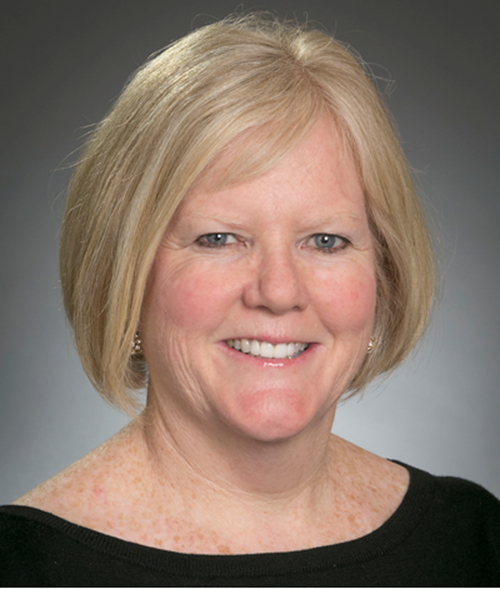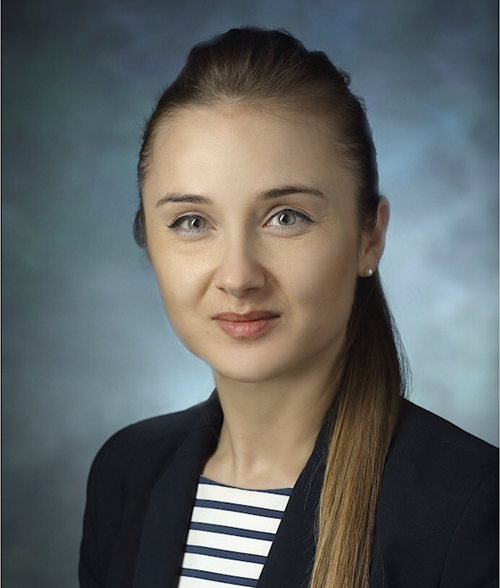
The AP's Role In Managing Patients With Early-Stage Multiple Myeloma
Case 1: High-Risk Patients
Patricia A. Mangan, RN, MSN, CRNP, Amy Pierre, MSN, RN, ANP-BC, and Oxana Megherea, PharmD, BCOP, discuss a case study of a patient with multiple myeloma who is eligible for a transplant. They review regimen options, discussing the benefits of using daratumumab for first-line treatment instead of saving it for a later treatment.
Chair

Patricia A. Mangan
RN, MSN, CRNP
University of Pennsylvania Abramson Cancer Center
Faculty

Amy Pierre
MSN, RN, ANP-BC
Memorial Sloan Kettering Cancer Center and Flatiron Health

Oxana Megherea
PharmD, BCOP
Penn Medicine
Transcript
Patricia Mangan: Welcome to this Roundtable discussion about early-stage multiple myeloma (MM) and the AP's role in managing these patients. My name is Patricia Mangan, and I'm a nurse practitioner at the Abramson Cancer Center of the University of Pennsylvania. Joining me today for this discussion are my two colleagues, Amy Pierre and Oxana Megherea. Amy is a senior clinical director of Flatiron Health and nurse practitioner at Memorial Sloan Kettering. Oxana is an oncology clinical pharmacy specialist at Penn Medicine. Amy and Oxana, thank you for joining me today. It's an exciting time in myeloma and initial therapy certainly is a focus of great interest of how best to prepare our patients for this long journey with myeloma. To get started, I will present a case just to lay out some of your decision-making in terms of how you would approach a newly diagnosed myeloma patient. The first case is a gentleman who's 67 years old, and he presents to his primary care doctor with complaints of fatigue and a 15-pound unintentional weight loss, over the past four months. He does have a history of hypertension and type two diabetes. He's married and just recently retired as a school educator. Blood work was conducted, and it turns out he has a white count, normal white count of 4.3. His hemoglobin, he is anemic, at 9.1, and platelets were in the normal range at 153,000. Creatinine 2.1, so a little renal insufficient. Calcium was normal at 9. He had an elevated total protein at 10 and an albumin of 3.3. Additional work was conducted, and he had a serum protein electrophoresis that did reveal a 2.2-gram IgG kappa m-spike. An IgG total protein quantitative level of 3,620, an IGA of 25, and an IgM of 9. He underwent a bone marrow biopsy, which was 60% cellular, but 50% of the cellularity were plasma cells. Of that, cytogenetics were conducted off of the aspirate, and he does have a positive FISH for a translocation of 4;14. I thought this might be a nice way to, just taking that case in mind, any ideas or thoughts of how you would approach this patient and choose initial treatment?
Amy Pierre: It's a really interesting case, Tricia. When we look at this patient, we have some comorbidities on board. We also have some cytopenias related to anemia, some renal failure. When I’m thinking about it, I’m thinking the anemia and the renal insufficiency is most likely a component of the myeloma. We should do our best to give this patient a really good regimen to clean out that packed marrow and get their anemia ok, get their renal insufficiency under control, to make them more of a solid candidate for something like a stem cell transplant. A lot of us have been looking at the alphabet soup that is MM. In terms of regimens, you take a little bit from column A, column B, column C, put them together, you have your regimen. Way back in the day we were looking at doublets versus triplets, and now we're fortunate to have so many drugs on the market, we're looking at triplets versus quadruplets in the first-line setting.
One of the really pivotal studies was the GRIFFIN trial looking at VRd, which is our standard of care for a robust stem cell transplant candidate, versus adding daratumumab to that VRd backbone. That trial was pretty impressive; patients were randomized to either arm, 4 cycles of each one went under a stem cell transplant, had 2 more cycles of consolidation therapy, and then went on to maintenance. And the VRd arm did lenalidomide maintenance. The dara VRd arm did dara plus lenalidomide maintenance for two years, and we've had a lot of follow-up. Those patients who were in the dara VRd arm had really deep responses, responses that were really durable, lasted a long time, and even deepened during the maintenance period, too. So, we've all been taught that giving patients sort of the best regimen up front, because that's when you get that deepest, most pronounced response, is really the best way to approach these patients. I think we really need to consider for patients, particularly those who are high-risk, having a quadruplet as an induction regimen, because that study even showed that if you look at all the subgroup analysis, regardless of stage, age, high-risk cytogenetics, the high-risk patients did really well in terms of a deep response and even MRD negativity.
Patricia Mangan: In terms of initial therapy, that's very attractive, that depth of response. Your choice of initial therapy, so you're mentioning dara, VRd, is there any time in a situation, Oxana, where you might defer to maybe doublet or a two-drug combination or do you have any thoughts on that choice of initial therapy?
Oxana Meghera: So I think that typically, unless the patient is very frail and has multiple comorbid conditions, where you would want to take a more gentle approach initially as necessary, typically at least a triplet we would utilize the listed triplet with the addition of a daratumumab either to RVd or, for example, in a patient with renal dysfunction to CyBorD until we get the renal function, the kidney working a little better would be options that we would have and then we could implement. In terms of when to use dara in addition to either one of the triplets, I think that there are different types of scenarios where we may consider in our practice right now; cytogenetic risk may play a role in that setting, or for example, in a patient perhaps that has a standard or intermediate risk but presents with more acute disease. For example, with a spinal cord compression or severe renal dysfunction, you would want a deep response, hopefully sooner to prevent progression to dialysis and hopefully less pain. That's a situation where you would use daratumumab up front. Another strategy that we typically employ, we may start with the triplet, and if we reach a plateau in terms of response, we may add daratumumab, for example, after 1 or 2 cycles to get them to that best response before the transplant.
Patricia Mangan: What I hear is that an important aspect of this is really closely monitoring, particularly with any of our patients, but those with more serious comorbid issues and the choice of adding to, or maybe if there's a toxicity emerging, lessening some of the doses or adjusting that, [with] a close monitoring through that time. The other point that, Amy, you brought up is when you're choosing an initial therapy, whether someone is a candidate for transplant, as you mentioned, sometimes, it used to be a very important decision that we would make where if someone of a certain age or a comorbid status, we would choose a regimen that we would be concerned they wouldn't be able to get a transplant. Now I think that most people we consider always giving them the option of potentially a transplant because quickly turning their disease around, maybe someone who's very frail or unwell on initial diagnosis gets on some of these more aggressive therapies of triplet or quad can definitely benefit and become a candidate when normally, because I think our standard of care is transplant even into their seventies. I see that too where we're moving more to triplet or even the component of daratumumab along with triplet combination.
Another question with the initial line of treatment, no matter what the induction therapy is, whether they move on to transplant or not, I think a question that comes up frequently is length of therapy or that maintenance aspect. Once someone has achieved their best response, how do we maintain that remission? We know that in myeloma, that first remission tends to be the longest, so how best can we optimize that? Many of the trials, particularly that you mentioned, Amy, and the GRIFFIN trial, where the dara and lenalidomide continued, but then there was a stop of the dara aspect of it at 18 months and other studies have done that. Just in your practice, any experience or thoughts on stopping? Some practices I've seen actually stop sooner than 18 months and any thoughts of why that might be happening?
Amy Pierre: That's an excellent question. I think in the GRIFFIN trial, they even went beyond 18 months. I believe they went for lenalidomide with dara versus lenalidomide for 2 years, with the option of holding the lenalidomide at 2 years or continuing. They're even pushing longer than that sort of 18-month mark that we're used to seeing in trials. But there's so much data to support that, during the maintenance period, people are deepening their response during maintenance. So, you're really optimizing usage of that drug in the maintenance period because you're really prolonging their length of remission when you're even deepening it more. And I know there're even earlier trials looking at sort of the length of maintenance therapy in general and if stopping is a good idea.
Oxana Meghera: It will depend on the maintenance strategy too. Each trial did something different too, which sometimes guides our practice on how to do it. For example, for lenalidomide, which remains really the most commonly employed maintenance strategy in our practice, there are different studies that some of them stopped at one year, for example, the IFM study. And then we have the newer DETERMINATION study that continued until progression of disease or intolerance, and we can clearly see that there is, even with a cross-study comparison, which is unfortunately what we have, we can clearly see a progression-free survival of about 20-plus months with the DETERMINATION study over the IFM study with continued lenalidomide maintenance. Another important area of research right now is MRD-guided duration of therapies. We have a couple of different studies that are looking at daratumumab with lenalidomide versus lenalidomide and the MRD testing and with sustained MRD testing cessation on just continuing to observe the patient. And I think we still have to wait a little bit to get a clear answer to that question.
Patricia Mangan: To your point, Oxana, in our heart of hearts, we still are not really curing people of myeloma. In our practice, at least I try to educate our patients that the verdict’s still out about when to stop therapy, if that's a possibility. So, managing these maintenance patients and doses and managing the toxicities that may emerge is a very helpful thing just to maintain that remission. Today I'm not sure that any of these treatments are really curing people and that's why it's such an essential aspect. Patients look towards MRD testing as a surrogate to “now I can stop treatment.” Hopefully, we may find out from some of these trials that you mentioned that we can comfortably, in certain populations of patients, do that. That's still to be determined as you mentioned.
This has been a very helpful discussion in terms of just that first-line approach. Some of the thoughts that we have, particularly in those frail people that may benefit with initial treatment and move on to a transplant when we would consider them not eligible previously. And also, in patients that may have comorbid issues or age or frailty that won't allow them to move on to transplant. And maximizing the responses that we can achieve and then maintaining that with some of these maintenance strategies. Thank you for that discussion.
